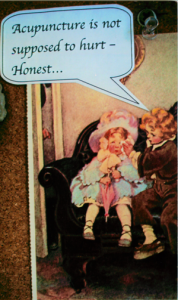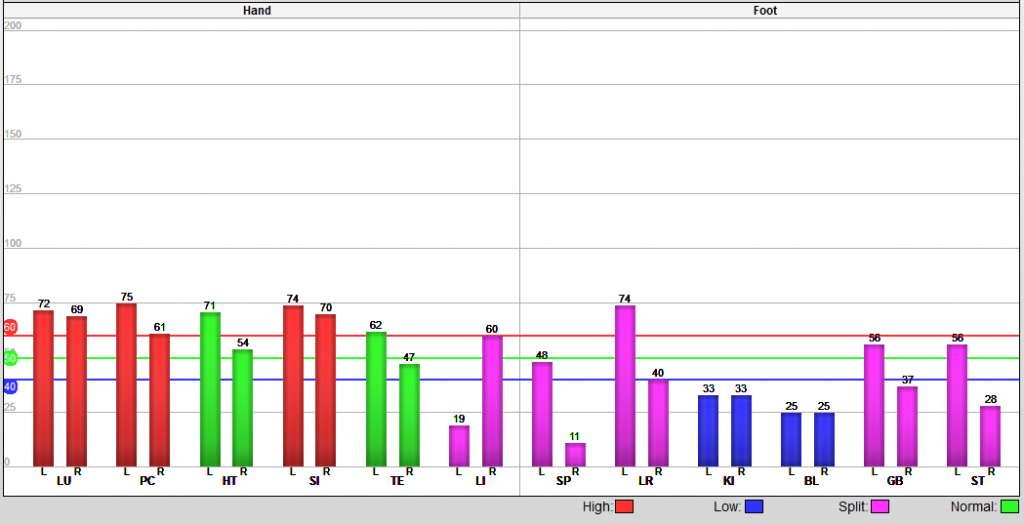Last week, I put needles into my patient and she began to cry. This is not the first time that this has happened in my office. In fact, I keep a box of tissue nearby for those who cry after the needles are inserted. When you are an acupuncturist, it may not be a good idea to have a reputation of making patients cry—but sometimes there are exceptions to the rule.
Case History:
 The patient presented with migraine headaches and lower back pain. Her migraines began in her mid 20’s and have continually gotten worse over the years. She described her pain as a “hot poker stabbing her in the right eye and going to the brain.” They never completely go away. She had migraine surgery several years back which brought some relief for about six months, however the pain has managed to find a new pathway to her brain. She is incapacitated 80% of the time and feels that 90% of her life is dysfunctional. She is not able to take typical migraine prescription medications for relief because she had a myocardial infarction. She complains of dizziness and loss of equilibrium, resulting in frequent falls. A recent fall led to the low back pain that she was experiencing on the day she came to me.
The patient presented with migraine headaches and lower back pain. Her migraines began in her mid 20’s and have continually gotten worse over the years. She described her pain as a “hot poker stabbing her in the right eye and going to the brain.” They never completely go away. She had migraine surgery several years back which brought some relief for about six months, however the pain has managed to find a new pathway to her brain. She is incapacitated 80% of the time and feels that 90% of her life is dysfunctional. She is not able to take typical migraine prescription medications for relief because she had a myocardial infarction. She complains of dizziness and loss of equilibrium, resulting in frequent falls. A recent fall led to the low back pain that she was experiencing on the day she came to me.
This was one of those patients who had tried everything else, so she decided to give acupuncture a try.
Graph results:
This was a difficult case and I knew that there would be a lot of layers involved in helping this patient. My first goal was to treat the imbalances which were appearing on the graph. As soon as I was done putting in the tonification and sedation points, I asked her how she was feeling. She told me that the pain seemed as if it were going away. I asked her the exact location of where she was still experiencing pain. She said that it was through her eye but more localized.
I put one more needle somewhere near Liver 3 and she began to cry!
I asked her if she was okay, and she said: “The pain is completely gone… I don’t know how you did it, but I am not feeling any pain.” I let her sit with the needles in for another 20 minutes or so. When she got up off of the table she was equally surprised to find out that her back pain was also gone.
I share this story, not because I did anything wonderful and amazing. I share this story because I am convinced that balancing the graph is what caused the amazing results for this patient. It is my experience that if you balance the graph before you try to deal with any presenting symptoms, the patient gets better twice as fast and the treatment results are longer lasting. The graph tells a story of what is going on energetically in the body. In fact, I am finding that 80% of the patient’s symptoms disappear simply by balancing the graph. If we trust the graph before we go in and start taking care of symptoms, then we become better practitioners.
It’s okay with me that I am gaining a reputation around town of making my patients cry. I’ll take the happy tears from happy patients any day of the week. This is just another reason why I love my job.
Have a fabulous week!
Kimberly Thompson, L.Ac.
kimberly@miridiatech.com
Acupuncture Research Analyst



The real happiness is to make others happy.Well done Dr.
Great result Kimberly! Did you graph the jing well or source pts or both? Am also curious why you needled “somewhere” near Liver 3. Matt
Hello Matt,
#1: I graphed the source points for this patient.
#2: When I was in school to become an acupuncturist I had to learn the ‘textbook’ locations for all of the points in order to pass exams. In the real world of acupuncture, I find the point based on what I feel under my finger. So–my statement was just referring to the fact that I felt for the point and on that particular day I may have felt the energy between Liver 2 and Liver 3–instead of on the textbook location. The longer I am in practice, the more I trust what my fingers are telling me.
I hope this helps.
Kimberly
Can you describe how you feel the energy by finger, Is there any practise or tool to detect the energy variations?
I wish that I had a wonderful explanation of how I feel through my fingers. I believe that this talent came through many years of practicing as a massage therapist before I became an acupuncturist. AcuGraph is designed to detect acupuncture point locations. The energetics of the body are always in a flow of constant movement. You can use AcuGraph to identify exact locations of lower electrical skin resistance. It could take years to develop the sensitivities in your fingers, but the electrical resistance of an acupuncture point can be found instantaneously with the AcuGraph probe.
In order to utilize AcuGraph for a single point examination, switch your exam type to a Singe Point Exam. I would suggest playing with this option to find better skin resistance locations int he acupuncture points. Good luck!
Kimberly
This is really Amazing .
It is a miracle happening. It is encouraging for Acupuncture.
Acupuncture for multiple seclerosis
Here is a link for a previous blog post which I wrote on Multiple Sclerosis. I hope this helps: http://www.miridiatech.com/news/?p=1467#more-1467
wondrful ur so professional no pain no gain
acupuncture for obesity
I suggest that you take a look at our Auriculo PC program. I get great results in my practice with weight loss patients by treating the ears. Our Ear Cure book also gives details on how to utilize auricular therapy for weight loss.
http://www.miridiatech.com/products/auriculo/pc.php
http://www.miridiatech.com/shop/en/auricular/ear-cure-book.html
Kimberly
This, in fact, is very encouraging.
No doubt, Acugraph is great tool to determine the energy imbalances, at the same time chinese syndrome knowledge is essential to treat the particular symptoms, especially in given example multiple problems is shown we accounted for liver pathology more, so in this aspect Acugraph Developer should incorporate the treamtment protocol according to the Acugraph diagnosis, symptoms basic and history of the graph basic in future. I accept everything is there now, but still we need capsulated manner including chinese syndrom, back shu, divergenet princple, all together into the particular symptoms, that is really expert treatment protocols.
Consiered in future development.
Thank you
with regards
s.saravanan
India
Thanks for sharing…acupunture point detection shall we use Stimplus pro? In acugraph, each point we measure it shows varies results which cause little confused. Kindly explain in detail., because exact point detection is the success key.
hi doctor am so impressed that you can write to me and not only did that patient cry but my self i do it offense because i fear injection so keep that good spirit doctor
Dear Kimberly thank you for sharing, please take a look on this experience:
(Movie: 9000 Needles)
your comments will be appreciated
Roberto,
I have seen the movie “9000 Needles” and found it very inspiring. I would love the opportunity to study in China at some point in time. In America, we don’t have the opportunity to treat very many of our patients on a daily basis. I believe that the most effective treatment comes with treating the patient daily. Some day I would love to study there.
Kimberly